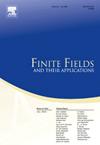(σ,τ)-derivations of group rings with applications
IF 1.2
3区 数学
Q1 MATHEMATICS
引用次数: 0
Abstract
Leo Creedon and Kieran Hughes in [18] studied derivations of a group ring RG (of a group G over a commutative unital ring R) in terms of generators and relators of group G. In this article, we do that for -derivations. We develop a necessary and sufficient condition such that a map can be extended uniquely to a -derivation D of RG, where R is a commutative ring with unity, G is a group having a presentation (X the set of generators and Y the set of relators) and is a pair of R-algebra endomorphisms of RG which are R-linear extensions of the group endomorphisms of G. Further, we classify all inner -derivations of the group algebra RG of an arbitrary group G over an arbitrary commutative unital ring R in terms of the rank and a basis of the corresponding R-module consisting of all inner -derivations of RG. We obtain several corollaries, particularly when G is a -FC group or a finite group G and when R is a field. We also prove that if R is a unital ring and G is a group whose order is invertible in R, then every -derivation of RG is inner. We apply the results obtained above to study σ-derivations of commutative group algebras over a field of positive characteristic and to classify all inner and outer σ-derivations of dihedral group algebras (, ) over an arbitrary field of any characteristic. Finally, we give the applications of these twisted derivations in coding theory by giving a formal construction with examples of a new code called IDD code.
(σ,τ)-群环的导数及其应用
Leo Creedon和Kieran Hughes在[18]中研究了群环RG(群G在交换一元环R上的)在群G的生成子和关联子上的衍生。在本文中,我们对(σ,τ)-衍生子做了同样的研究。给出了映射f:X→RG可以唯一地扩展到RG的a (σ,τ)-导数D的充分必要条件,其中R是一个具有单位的交换环,G是一个具有< X|Y >表示的群(X是生成子集合,Y是相关子集合),(σ,τ)是RG的一对R-代数自同态,它们是G的群自同态的R-线性扩展。我们根据由RG的所有内(σ,τ)导组成的相应R模的秩和基,对任意交换一元环R上任意群G的群代数RG的所有内(σ,τ)导进行分类。我们得到了几个推论,特别是当G是(σ,τ)-FC群或有限群G和R是场时。我们还证明了如果R是一个单环,G是一个在R中阶可逆的群,那么RG的每一个(σ,τ)导数都是内的。应用上述结果研究了交换群代数在具有正特征域上的σ-派生,并对具有任意特征域F上的二面体群代数FD2n (D2n= < a,b|an=b2=1,b - 1ab=a - 1 >, n≥3)的所有内外σ-派生进行了分类。最后,通过给出一种称为IDD码的新码的形式化构造,给出了这些扭曲导数在编码理论中的应用。
本文章由计算机程序翻译,如有差异,请以英文原文为准。
求助全文
约1分钟内获得全文
求助全文
来源期刊
CiteScore
2.00
自引率
20.00%
发文量
133
审稿时长
6-12 weeks
期刊介绍:
Finite Fields and Their Applications is a peer-reviewed technical journal publishing papers in finite field theory as well as in applications of finite fields. As a result of applications in a wide variety of areas, finite fields are increasingly important in several areas of mathematics, including linear and abstract algebra, number theory and algebraic geometry, as well as in computer science, statistics, information theory, and engineering.
For cohesion, and because so many applications rely on various theoretical properties of finite fields, it is essential that there be a core of high-quality papers on theoretical aspects. In addition, since much of the vitality of the area comes from computational problems, the journal publishes papers on computational aspects of finite fields as well as on algorithms and complexity of finite field-related methods.
The journal also publishes papers in various applications including, but not limited to, algebraic coding theory, cryptology, combinatorial design theory, pseudorandom number generation, and linear recurring sequences. There are other areas of application to be included, but the important point is that finite fields play a nontrivial role in the theory, application, or algorithm.

 求助内容:
求助内容: 应助结果提醒方式:
应助结果提醒方式:


